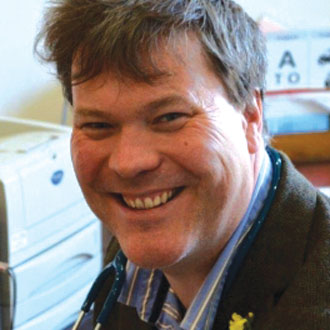
Dr Matt Burkes
Dr Matt Burkes
The ePortfolio is an online record of your training journey, from starry-eyed ST1 to seasoned veteran of the RCGP exams. It is through this portal that all your various rotations, myriad successes and occasional failures will be recorded. The RCGP is very keen on the ePortfolio and describes it as ‘the glue which holds the curriculum learning and assessment together’.1
One sunny day late in your registrar year, you will sit together with your trainer hunched over the ePortfolio and complete your final review. You will together press the ‘submit’ button that will lead to your Certificate of Completion of Training.
I know the ePortfolio can be infuriating. I remember being told that using it was good for me because it would give me good practice for the post-qualification appraisal interface. I was no more convinced by that argument then, than you are by it now. It is fair to say that I was anything but a fan of the ePortfolio.
But I came to realise that the ePortfolio was not going away, and if I wanted to be a GP in the UK I was going to have to use it, and master it.
You need to show you are capable of planning and delivering a programme of self-directed learning
So I set out to work with the ePortfolio rather than against it. Essentially, the ePortfolio is the device by which you can prove, with evidence, that you are fit to become an independent GP, having covered all the topics laid out in the RCGP curriculum. The RCGP demands this but, more importantly, so does the general public.
Everything related to the ePortfolio goes towards this ultimate aim. It is your passport to your future career. Understanding this is very important. Now you can look at the tasks required of you in this context, rather than just a seemingly random list of time-consuming irritants.
There are many facets to the ePortfolio. It is a repository for your workplace based assessments and clinical skills assessment and applied knowledge test results, but the area that most frequently vexes the GP trainee is the learning log. This truly is the section that puts the ‘continual’ in ‘continual assessment’.
Again, it helps to look at it in the context of the long-term purpose of the ePortfolio. Learning log entries should allow you to show clear evidence of learning and progression throughout your training. Without this proof, how can you be signed off as an independent professional whose career has taken them out of the spoon-fed hospital training setting and into the wilds of the community, where staying up-to-date and keeping your skills in good working order is solely your responsibility? You need to show you are capable of planning and delivering a programme of self-directed learning.
This is best achieved by a mixture of entries – fact-based pieces and more reflective pieces. We’ll come to reflection a little later – let’s start with the former, easier pieces.
Fact-based entries
Personally, I think it is very sensible to keep a log of your tutorials and teaching sessions. You could also put in what you are reading, what you have had to look up and useful websites/resources that you have come across. These show that you are doing some work, that you are capable of self-directed learning and, much more importantly, provide you with a secure personalised library of resources that will allow you to access these gems of information later when you have forgotten them. Keep this in mind – if you are doing the work, then make sure that you are getting the credit and the benefit. You never know when this stuff will come in handy.
In teaching sessions, make notes – either digitally on your device of choice or the old fashioned way with pen and paper. There are many apps these days that allow you to use your phone as a scanner so you could always scan written notes and get them on the ePortfolio quickly with the minimum of fuss. There are also voice recognition programmes you could use to record and upload dictated entries, which could save you time.
The above will provide a good solid body of evidence of what you are learning, and a few learning log entries to boot… but that’s not enough. You need to also show evidence of reflective practice.
Reflective entries
What are these? And why do we find them so hard?
Reflection is the process by which we analyse our performance and make changes to improve subsequent outcomes. Of course, ‘reflection’ and ‘documenting reflection’ are two different matters. I don’t think anyone can argue with the utility of reflection as a process – who wouldn’t want to review their performance to improve it? In fact, whenever you get more than one doctor in a room, they will spontaneously reflect. They will do this by swapping stories about their practice. Think about your VTS meeting: what do you all do when you get together for a cup of tea?
So why do we find this hard to write down? And why do we have to?
From our earliest days of medical school we are schooled in NOT reflecting. Cast your mind back to your first ever clerking. It was probably a hotchpotch jumble of unstructured observation and emotions. We are schooled to apply structure to this chaos – presenting complaint, history of presenting complaint, past medical history etc. This is necessary, but in the process we often lose some of our emotional intelligence and observation. Fast forward a few years, when you’re the junior doctor presenting on the post-take ward round, and imagine this: ‘This is Mrs Smith, a 68-year-old woman whose care highlighted a number of areas of deficiency in my knowledge that I have an action plan to remedy. I also felt uncomfortable due to the following ethical issues raised…’
Well, I don’t know how your AMU consultant would have taken that, but mine, well you get the picture.
The point is that the reason that many people find it hard to write reflectively is that we have been drilled for years in the science of not writing reflectively.
There are two reasons why it is important to get into the process of doing this. The first, and most prosaic, comes back to our ability to provide evidence that we are capable of reflective practice. Saying ‘I do this is in my head’ is not providing evidence. Documenting it is.
The second reason is that by writing our reflections down we process them at another, deeper level. It forces us to really consider the situation, interrogate it and our actions and explore how we might have improved the outcome by acting differently. This process alters our perception of the event, often making new connections that just thinking about it or discussing it doesn’t. The process of writing generates new insights.
Print out the curriculum headings and ‘spot cases’ for your learning log
It also allows us to recognise that none of us practises in a vacuum. Factors that we bring to the consultation from our past (or present) may have a bearing on what happens. For example, if we have seen a similar presentation end badly previously it can affect our thinking, actions and communication. It’s useful to recognise these factors.
Good topics for reflective pieces include:
- Tricky cases – basically anything that put you out of your comfort zone.
- Ethical dilemmas.
- Consultations that went badly – these needn’t necessarily have been ‘your fault’.
- Consultations that went especially well.
- Anything that affected your feelings – either positively or negatively.
- Issues within the primary care team.
- Interactions with community/hospital teams.
Tips to get the most out of the learning log
Remember that this is about demonstrating curriculum coverage, so print out the curriculum headings and ‘spot cases’ to ensure you do this. The RCGP states: ‘There is no minimum number of learning log entries required for completion of training. However, there needs to be sufficient evidence of balanced curriculum and competence coverage.’1 The received wisdom is that about two to three reflective entries a week is about right.
Build the ePortfolio into your schedule – allocate time to write each working day. If you don’t do this, you may end up having to write multiple entries at once, late at night, just before your review. This is horrible to do, unlikely to be of much benefit to you and your trainer won’t enjoy being on the receiving end.
Try to write contemporaneously. The best way to do this is to make a few notes immediately after the consultation – just the bare bones, which you can then revisit when you have time to flesh them out. There are various ways of doing this – some have Word open on their desktop, some open the ePortfolio and type notes straight into that before later editing. Find what works for you and implement it. Do not rely on remembering interesting cases two weeks later – you are just too busy and the cases and details will slip through, leaving you with an empty ePortfolio.
Recognise and accept that reflective writing can be difficult. That means it’s fine if you are finding it difficult – you aren’t doing it wrong. Don’t stop, in fact write more frequently, as you will get better at it and it will become easier – we never stop learning. Don’t spend two hours grumbling and putting off a 15-minute writing task. And beware of spending too long on the clinical details or you will run out of steam when it comes to the reflection. Remember, this is not the post-take ward round; don’t let the clinical details get in the way.
Write in your own voice. This is not an exam or a case report for academic publication. Your descriptions are more compelling than the third person. The process is for your benefit.
Dr Matt Burkes is a GP partner and trainer in Chichester, West Sussex. He has written on many aspects of GP training and co-edited ‘The Good GP Training Guide’ (RCGP Press, 2014)
References
1 RCGP. The ePortfolio for specialty training. London: RCGP; 2014

















